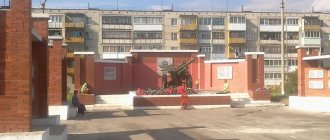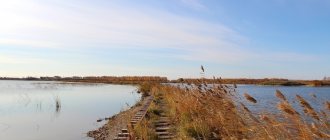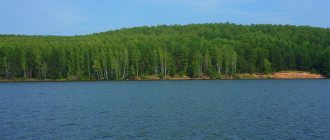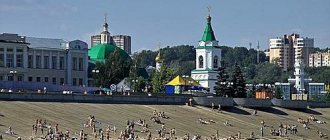Salavat is small in area, but at the same time one of the largest industrial cities in the Republic of Bashkortostan, which is located on the left bank of the Belaya River.
From Salavat to the capital of the republic, the city of Ufa, is approximately 150 kilometers. The city-forming enterprise in Salavat is Gazprom neftekhim Salavat, which is also the main source of deterioration of the environmental situation around.
The situation with emissions from the plant was partially resolved through the installation of modern filters.
Where to go
Our city of Salavat is small, its area is slightly more than 100 sq.m. But even we have places that are worth visiting for city guests. One day is enough to walk through them. But it is best to use public transport, a taxi or a personal car to move at a faster speed.
Stela Salavat Yulaev
Stele at the entrance to the city with the figure of the national hero Salavat Yulaev. It is located at the northern entrance. Designed by sculptor A.V. Semchenko.
Stele of Salavat Yulaev.
Museum of Local Lore
Walking along Pervomaiskaya Street (which was the first in the workers' village) you can reach the Museum of Local Lore. It was opened in 2009, but even over the years, historical exhibits have been collected. There are several exhibitions here - numismatic, archaeological, paleontological, ethnographic, and there is also a collection of books. Everyone will be able to find something interesting for themselves.
Palace of Culture of Neftekhimiki
Having reached the beginning of Pervomaiskaya Street we find ourselves on the square named after. Lenin. This is the main square of the city - the mayor’s office (administration) is located on it, the main festivals take place, and the main Christmas tree is installed. The Neftekhimik Palace of Culture is also located here, where concerts and performances by both local artists and state pop stars are often held. On the alley along Dzerzhinsky Street there is a stele to the First Builders. Opposite Neftekhimik there is a monument to V.I. Lenin, which is considered the main attraction for newlyweds who come to him to lay flowers.
Administration (mayor's office) and the Neftekhimik Palace of Culture.
Art Gallery
Not far from the square there is an art gallery, which displays paintings by local artists, as well as objects of art from different times.
Stele 40 years of the October Revolution
Moving straight along Lenin Street, you can walk along the alley, which was decorated in honor of the 100th anniversary of the autonomy of the Republic of Bashkortostan, as well as the stele in honor of the 40th anniversary of the October Revolution. On Victory Square there is the only October cinema in the city, which has been reconstructed into a more modern look.
Stele 40 years of the October Revolution.
Cinema October.
Memorial Eternal Flame
The Eternal Flame Memorial is definitely worth a visit. Several pieces of military equipment and a sculpture dedicated to internationalist soldiers are presented here. It is located on Salavat Yulaev Street, opposite the alley. Walking a little further you can see an open fountain - in hot weather it is always surrounded by children. Opposite is the Agidel Palace of Culture.
Monument to Internationalist Soldiers.
Park of Culture and Recreation
Those who like to walk should visit the parks. The main joy of Salavat residents is the Park of Culture and Recreation on Klyuchevaya Street. There is a fountain, a pond, plantings and paths between them. You can ride a bicycle or scooter along special paths. There are several playgrounds for visitors with children.
Fountain in the park of culture and recreation.
Thematic panels on the walls of houses
Along the streets of Oktyabrskaya, Lenin and Neftyanikov Avenue there are thematic panel paintings on the houses, which are distinguished by their symbolic execution. Also on some other streets in the old part of the city you can see more modern panels on houses.
Panel on the house.
Churches and mosque
For lovers of religious places, an Orthodox church was built in the city - the Holy Assumption Cathedral, the Cathedral Mosque, as well as two churches of Protestant denominations.
Holy Assumption Cathedral.
Cathedral Mosque.
Land of Yurmata
Outside the city, a memorial park was built, which is called the Land of Yurmaty. It is dedicated to 7 villages (Allaguvat, Maly Allaguvat, Irek, Karakul, Artel Kuch, Kyzyl Aul, Kozhak), on the territory of which the cities of Ishimbay and Salavat were built and their inhabitants participating in the Great Patriotic War.
Industrial facilities
Our city of Salavat is one of the industrial centers. Large production facilities are located here. Many business travelers and city guests come to visit them.
Gazprom neftekhim Salavat
Large oil refining chemical production. It is a city-forming enterprise. You can learn about its history in the Neftekhimik Palace of Culture. Thanks to this enterprise, the city was founded. It is constantly growing and organizing new workshops and factories, offering new jobs. There is a panel on the control wall that has a symbolic meaning - the unification of nations and professions.
Administrative building of the enterprise.
Salavatneftemash
A large engineering production facility that produces equipment for the chemical, petrochemical and oil and gas industries. They also produce various parts and repair equipment, produce metal structures, etc.
Central entrance of Salavatneftemash.
Salavatneftemash management.
Salavatglass
The company produces technical glass. The main product is sheet glass. It is used as double-glazed windows, automobile glass, glass containers, etc. Near the main entrance there is a fountain and a seating area.
Central entrance Salavatsteklo.
Our city is small and you can walk through it in 1 day. But everyone can find something interesting for themselves. At the same time, the city is constantly developing and transforming, becoming more beautiful and unique.
Lyana Rudakova
Native land. History of the city of Salavat.
The city with a proper name in its name - Salavat - is one of the youngest in our republic; last year it celebrated its 70th anniversary.
You don’t need to make any special efforts to imagine this city in Soviet times, the time of its formation, to feel its history. It is right here: just as then in numerous gardens and parks, bird cherry and apple trees bloom, children are still laughing and the tram is humming, and walking along Stroiteley Street, you can easily get to the center, Pervomaiskaya Street and Lenin Square, on which, I’m not afraid to say it, are located some of the best examples of the Stalinist Empire style. Why is all this happening in Salavat?
Salavat is a city of builders and petrochemists. The history of the city of Salavat is an illustration of how our parents and their parents, when young, built factories, houses, cities, and with common efforts built the future of the country in which they live.
Valentina Bukharina, local historian: “The main factor here is Bashkir oil, which was found here in the 30s in the village of Ishimbayevo. By 1936, this area approached Baku in terms of oil production, that is, the Starogroznensky district, and began to be figuratively called the “second Baku.” Ufa, Meleuz, Zirgan, Kuibyshev and so on were examined, but they settled on this place - flat, in the Bashkir steppe, there were several villages here. A railway was built through Salavat to Ishimbay. And most importantly, oil was nearby, there was a lot of it. It was decided to build an oil refinery, but the war interfered with these plans...”
In 1948, an initiative group with grandiose plans gathered in the practically empty steppe. Construction of the future industrial giant, urban planning enterprise, plant No. 18 begins. In the post-war years, the name was initially kept secret. Later it began to be called “Salavatnefteorgsinrtez”, today it is “Gazprom neftekhim Salavat”.
What are people willing to do to implement a good idea? Sleeping in tents on a bare field in winter? No problem! Build housing and factory workshops for days without rest? Please!
Yaudat Mazitov, builder, Honorary Citizen of the city of Salavat: “They built it very quickly, in a month or a month and a half, because they built it very quickly. Around the clock, day and night. Here machine cranes grew like mushrooms; there were 40-50 cranes in the city. It was necessary to provide people with housing, because a lot of people were arriving, especially young people, after the army. If they built it quickly, they got it quickly, it was good about that.”
Nina Aleksandrovna Kosarina, one of the builders, remembers how she arrived in a field where 117 tents of the first builders stood, there was even a bathhouse in the tent. About the bread for which we went to Ishimbay with a trailer on tractors or bulldozers. And also about the fact that she, a woman, had to accept the construction work of a special contingent, prisoners, 25,000 of whom were brought here for the most difficult work. Prisoners from all over the Soviet Union were brought to the large-scale construction site. They worked together with builders and lived mainly in neighboring Ishimbay.
Anas Saigafarov, veteran of Gazprom Neftekhim Salavat LLC: “Under the guidance of engineers, they did the rough work: mostly digging, carrying, bringing, carrying away... We went to practice when we were in school, sometimes they took us to workshops. But they definitely were. They were brought in and taken away in formation. I remember this well.”
Yaudat Mazitov, builder, Honorary Citizen of the city of Salavat: “When they passed, there were probably 5,000 people there, we sat and waited for them to pass. For prisoners, the area where they worked was closed. But there were also free people - almost without security, 1 person brings them and they work together with everyone else. The free ones worked right along with me. These two-story residential houses are still standing - they built them all. This was before my time.”
Gradually, a barracks-type workers' settlement appears - Novostroika.
Valentina Bukharina, local historian: “When the first builders came here, there was no name. Construction site, Industrial site...”
After a year of active work, the new building already bears the name Salavat, but it is still far from achieving city status.
Valentina Bukharina, local historian: “Pervomaiskaya Street crosses this square; it was built up already in 1952. Imagine, 1948 - there was nothing here yet, there was a huge lake on the square. Our area is swampy and low-lying.”
The architecture in our cities is a silent witness to all the ups and downs of the city, its fate. In this sense, Salavat has a rather telling appearance.
Valentina Bukharina, local historian: “In 1952, Ivan Afanasyevich Berezovsky was appointed head of the construction department of plant No. 18. He is a Muscovite, he came to us as a referral, and had extensive experience in processing and construction. He himself specially went to Leningrad, picked a very strong team of talented designers there and brought them here. It’s no coincidence that we have many places that are connected with Leningrad, for example, Leningradskaya Street.”
Salavat has been showing record results since its inception in terms of the pace of construction, both industrial and social.
Valentina Bukharina, local historian: “Hundreds of thousands of people came to build it: university graduates, demobilized soldiers and even captured Germans. And then in the mid-50s Salavat was declared an all-Union construction site, how many young people came here on Komsomol vouchers!”
Honored builder, honorary citizen of the city of Salavat Mazitov Yaudat Zigannurovich recalls how his Komsomol youth threw him into the city under construction:
“I came to the city on a Komsomol ticket in 1961 as an 18-year-old guy and went to work at the Salavatstroy trust as a bricklayer. I am from Chekmagushevsky district, Urnyak village.
In the 60s, only young people worked in Salavat, there was a youth town.”
Two veterans tell me about the Komsomol shock construction project, but they do it with such passion and love for their work in life that pictures immediately appear in the imagination of the most active and perky youth coming together, working, building, living... Hence the romance - Salavatites they really loved hiking with guitars and songs, playing sports, dancing in the streets... Everyone - all together, friendly and fun, lived like real pioneers.
Yaudat Mazitov, builder, Honorary Citizen of the city of Salavat: “Even 25-30 kilometers were covered on skis, we had a ski track, even with lighting. They drank tea in the forest. In the summer too - young people went to dance right on the grass. We called this “taptogon”. We gathered in the evening with accordions and danced.”
Valentina Bukharina, local historian: “The romance of the construction site was captivating. These were mostly young people, so they started families, got jobs, housing, and of course, this is how they gradually became city veterans from university graduates and pioneer builders.”
Yaudat Mazitov, builder, Honorary Citizen of the city of Salavat: “I met a girl, got married, and started working as a mason foreman. The city was built, residential buildings were built by a plant, a glass factory, an optical-mechanical factory. We worked very friendly, there were 17-18 people in the brigade, they understood each other perfectly, the atmosphere was very good.”
At the end of this interview, I wanted to understand how those who built the urban planning complex, the whole city, and lived in it all their lives feel.
Yaudat Mazitov, builder, Honorary Citizen of the city of Salavat: “I walk around and think: this house was built then, this one was built then. People live, people rejoice and we are happy about it. The streets are beautiful. I’ve liked this city all my life, I don’t want to leave.”
The village, and then the city, appeared on the site of the villages Allaguvat, Karlykul, Kudakai, Irek, Kyzyl-aul - 7 villages in total. Today there is a monument on this site, created as a tribute to history and considered one of the attractions of Salavat.
Valentina Bukharina, local historian: “On the 167th kilometer of the Ufa-Orenburg highway, at the junction of three districts - Sterlitamak. Ishimbaysky and Meleuzovsky memorial complex was built and opened. Yurmaty is one of the seven nation-forming Bashkir tribes on the initiative of the public organization "Allaguvat" in 2003.
From the main stele, paths lead to stones that symbolize 7 resettled villages. The soil from each of the villages is placed in a bowl near the stones. They had to be resettled because the construction of the plant deteriorated the environmental situation; water and village residents gradually moved to Salavat. In order to preserve the memory of their small homeland, residents created a place where they could come.
For them, the residents of Salavat, the construction of this city was their most cherished dream. Therefore, the story of Salavat is the quintessence of youth, initiative, hopes and achievements, youthful impulse, tears and smiles.










